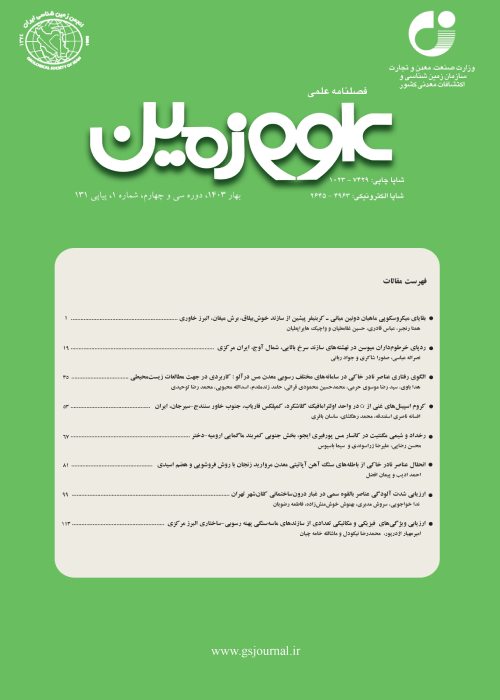The Magnetic Characteristics of Sandstone Rocks of Shemshak Group in Response to Application of Geomagnetic Methods
Author(s):
Abstract:
Geomagnetism is one of the most applied techniques of geophysics in geology. Today, this method is applied in different disciplines such as Magnetic fabric of rocks, palaeomagnetism and environmental magnetism. Each of these magnetic methods is suitable for a particular lithology. Therefore, the potential of sandstones of Shemshak Group, in central Alborz Mountain range were examined to record their response to the application of some conventional magnetic methods. This rock unit is formed during two major tectonic events of early and middle Cimmerian and has great coverage not only in the study area but also in a vast majority of Iran. The total number of 135 oriented core samples was taken from 18 stations. In this study combination of magnetic and petrographic data are examined. The result of magnetic mineralogy analysis of all samples (except samples from stations 10 and 15) show irreversibility i.e. minerals such as hematite and magnetite, have formed during the heating stage. The results of thermal demagnetization analysis showed that ferromagnetic minerals present in the samples (except samples from stations 10, 14 and 15) have demagnetized below 400 °C and by proceeding heating, samples show zigzag pattern or show abnormal increase in susceptibility. This indicates that, the magnetic minerals are formed during heating in one stage and due to unstability lose its susceptibility in other stage. The magnetic susceptibility (Km) vary from 200-400×10-6 SI for more stations of study area, indicating abundance of paramagnetic mineral in this rock unit. From petrography point of view all the sandstone samples are classified as arenites and ratio of quartz to lithic fragment and feldspar is relatively low, which may indicate low mineral maturity. Comparison of magnetic mineralogy and thermal demagnetization data for two stations S10 and S15 show that there is an inverse potential relationship between amount of stable ferromagnetic mineral in a sample and amount of its alteration during heating stage. The results of this study reveal the poor nature of Shemshak Group sandstones for palaeomagnetic studies due to their low mineral maturity and water percolation which increase the possibility of acquisition of chemical remanent magnetization (CRM). The high sedimentation rate of sandstones cause magnetic inclination and declination error, and low ferromagnetic mineral fraction in samples, make them unsuitable to record magnetic directionsduring formation of rocks. However, abundance of paramagnetic minerals such as biotite in these rocks, proves their applicability for magnetic fabric studies.
Keywords:
Language:
Persian
Published:
Geosciences Scientific Quarterly Journal, Volume:24 Issue: 95, 2015
Page:
153
magiran.com/p1436440
دانلود و مطالعه متن این مقاله با یکی از روشهای زیر امکان پذیر است:
اشتراک شخصی
با عضویت و پرداخت آنلاین حق اشتراک یکساله به مبلغ 1,390,000ريال میتوانید 70 عنوان مطلب دانلود کنید!
اشتراک سازمانی
به کتابخانه دانشگاه یا محل کار خود پیشنهاد کنید تا اشتراک سازمانی این پایگاه را برای دسترسی نامحدود همه کاربران به متن مطالب تهیه نمایند!
توجه!
- حق عضویت دریافتی صرف حمایت از نشریات عضو و نگهداری، تکمیل و توسعه مگیران میشود.
- پرداخت حق اشتراک و دانلود مقالات اجازه بازنشر آن در سایر رسانههای چاپی و دیجیتال را به کاربر نمیدهد.
In order to view content subscription is required
Personal subscription
Subscribe magiran.com for 70 € euros via PayPal and download 70 articles during a year.
Organization subscription
Please contact us to subscribe your university or library for unlimited access!


